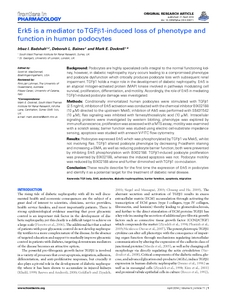Badshah, II; Baines, DL; Dockrell, ME
(2014)
Erk5 is a mediator to TGFβ1-induced loss of phenotype and function in human podocytes.
Frontiers in Pharmacology, 5 (71).
ISSN 1663-9812
https://doi.org/10.3389/fphar.2014.00071
SGUL Authors: Baines, Deborah
![[img]](https://openaccess.sgul.ac.uk/107093/1.hassmallThumbnailVersion/fphar-05-00071.pdf)  Preview |
|
["document_typename_application/pdf; charset=binary" not defined]
Published Version
Download (1MB)
| Preview
|
Abstract
Background: Podocytes are highly specialized cells integral to the normal functioning kidney, however, in diabetic nephropathy injury occurs leading to a compromised phenotype and podocyte dysfunction which critically produces podocyte loss with subsequent renal impairment. TGFβ1 holds a major role in the development of diabetic nephropathy. Erk5 is an atypical mitogen-activated protein (MAP) kinase involved in pathways modulating cell survival, proliferation, differentiation, and motility. Accordingly, the role of Erk5 in mediating TGFβ1-induced podocyte damage was investigated.
Methods: Conditionally immortalized human podocytes were stimulated with TGFβ1 (2.5 ng/ml); inhibition of Erk5 activation was conducted with the chemical inhibitor BIX02188 (10 μM) directed to the upstream Mek5; inhibition of Alk5 was performed with SB431542 (10 μM); Ras signaling was inhibited with farnesylthiosalicylic acid (10 μM). Intracellular signaling proteins were investigated by western blotting; phenotype was explored by immunofluorescence; proliferation was assessed with a MTS assay; motility was examined with a scratch assay; barrier function was studied using electric cell-substrate impedance sensing; apoptosis was studied with annexin V-FITC flow cytometry.
Results: Podocytes expressed Erk5 which was phosphorylated by TGFβ1 via Mek5, whilst not involving Ras. TGFβ1 altered podocyte phenotype by decreasing P-cadherin staining and increasing α-SMA, as well as reducing podocyte barrier function; both were prevented by inhibiting Erk5 phosphorylation with BIX02188. TGFβ1-induced podocyte proliferation was prevented by BIX02188, whereas the induced apoptosis was not. Podocyte motility was reduced by BIX02188 alone and further diminished with TGFβ1 co-incubation.
Conclusion: These results describe for the first time the expression of Erk5 in podocytes and identify it as a potential target for the treatment of diabetic renal disease.
| Item Type: |
Article
|
| Additional Information: |
Copyright © 2014 Badshah, Baines and Dockrell. This is an open-access article distributed under the terms of the Creative Commons Attribution License (CC BY). The use, distribution or reproduction in other forums is permitted, provided the original author(s) or licensor are credited and that the original publication in this journal is cited, in accordance with accepted academic practice. No use, distribution or reproduction is permitted which does not comply with these terms. |
| Keywords: |
Erk5, TGF-beta, apoptosis, barrier function, diabetic nephropathies, migration, podocytes, 1115 Pharmacology And Pharmaceutical Sciences |
| SGUL Research Institute / Research Centre: |
Academic Structure > Infection and Immunity Research Institute (INII) |
| Journal or Publication Title: |
Frontiers in Pharmacology |
| ISSN: |
1663-9812 |
| Related URLs: |
|
| PubMed ID: |
24795631 |
| Web of Science ID: |
24795631 |
| Dates: |
| Date |
Event |
| 2014-04-21 |
Published |
|
 |
Go to PubMed abstract |
| URI: |
https://openaccess.sgul.ac.uk/id/eprint/107093 |
| Publisher's version: |
https://doi.org/10.3389/fphar.2014.00071 |
Statistics
Item downloaded times since 10 Dec 2014.
Actions (login required)
 |
Edit Item |



